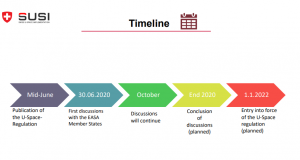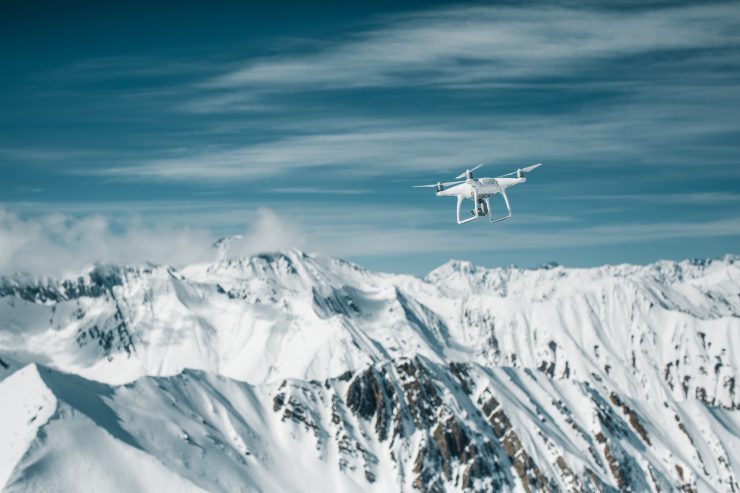By Jenny Beechener
The Swiss U-Space Implementation (SUSI) programme is in the process of implementing Networked Remote Identification (ID). According to Switzerland’s regulator, the Federal Office of Civil Aviation (FOCA), Networked Remote ID will help to make drone operations safer by delivering transparent drone operations for citizens, drone operators and authorities. Speaking at the SUSI webinar The U-Space project – the future of drones in Switzerland: an update on 27 August 2020, FOCA Digital Transformation Architect Benoit Curdy said: “Remote ID is included in current regulation but you need to be near the action to pick up the signal and see who is flying. With Networked Remote ID, you can see this from anywhere. This brings clear advantages for operators and authorities.” Implementation is straightforward and achieved through connectivity – for example by cell phone – to the network. “A U-space service provider is able to share ID information so it is visible anywhere and compliant with private data protection rules.”
FOCA is drawing on standards development elsewhere to support its implementation programme. SUSI is using ASTM remote ID standards – published in February this year – for broadcasting identity information to authorities, including security organisations at a local level. SUSI is now looking to expand the concept to include networked connectivity, so remote ID information can be used for traffic management services by UTM service suppliers.
FOCA Legal Advisor Sandra Bodmer said U-space regulation is the “missing piece in the regulatory package for unmanned aircraft”. Europe published regulation EU 2019/945 in mid-2019, which specifies requirements for the Unmanned Aerial System (UAS) itself, followed by Implementing Regulation 2019/947, which contains the rules regarding the operation of those unmanned aircraft. “However, the regulations don’t cover how to integrate these new aircraft into the current airspace with existing users.” This is necessary to enable the collection of decentralised services known as U-space services to support safe and efficient integration of drones into the airspace and enable drone flights alongside manned aviation.
SUSI aims to develop a legal framework for national implementation in Switzerland and influence the European regulatory process on the basis of practical experience. FOCA is relying on industry cooperation to build up the whole system with its numerous services.
Networked Remote ID is just one of multiple U-space services needed to support safe integration of drones into the airspace alongside existing users. A European Aviation Safety Agency (EASA) taskforce launched 18 months’ ago is working on regulation and standardisation of U-space services in order to support growing demand for done operations and services. While FOCA is focused on implementation of SUSI in Switzerland, the regulator says regulation needs to be collaborative effort. “Whenever there is a new service available, like Networked Remote ID, it needs to be extensively tested. The goal is to have mutual exchange of knowledge so lessons can be learned from demonstrations and we can achieve a uniform approach to implementation of requirements in Europe,” explained Curdy. The process will move faster if industry plays an active role in identifying necessary standards.
Curdy explained there are two sides to U-space: the authority side and the market. It is important for information to be exchanged between the two. The Flight Information Management System (FIMS) lies at the centre of the system, sharing information provided by the air navigation service provider such as traffic information, NOTAMs and the U-space utility map. The authorities provide additional information such as drone registration and geozones, while U-space service providers deliver the multiple services required by drone operators to conduct their business.
In addition to Networked Remote ID, SUSI is working on U-space services including weather, conformance monitoring and operations sharing. Curdy refers to this as U-space service to U-space service (USS to USS). “The work is well advanced,” said Curdy. “You want to have single picture of airspace so these two sides can share information including dynamic restrictions, police operations. Industry provides the platform that allows real-time data sharing.”
FOCA’s efforts are directed towards ensuring data standards are harmonised to enable this level of information sharing by multiple service providers.
“The drone operator doesn’t have to understand the technical planning,” explained Curdy. “This is invisible. U-space is meant to make life easy. A drone operator simply picks their drone manufacturer and U-space service provider based on their requirements.”
FOCA plans to provide information on what is working well in the standards development through a policy of “build a little, test a little”. The results will influence development of the regulations.
Europe is pursuing an ambitious target to deliver its U-space regulation. Since EASA established the taskforce in 2019, the agency delivered its draft opinion to the Commission in March 2020, addressing competency and rule-making for a High-level regulatory framework for the U-space. The proposal prompted many ideas and has contributed to in-depth discussions starting in June 2020. These are due to reach a conclusion towards the end of 2020 when the Commission is expected to adopt implementing rules. These would pave the way for the introduction of U-space regulation by January 2022.

EASA Opinion 01/2020
https://www.easa.europa.eu/sites/default/files/dfu/Opinion%20No%2001-2020.pdf
For more information visit:
(Image: By denis kalinichenko/Shutterstock)




